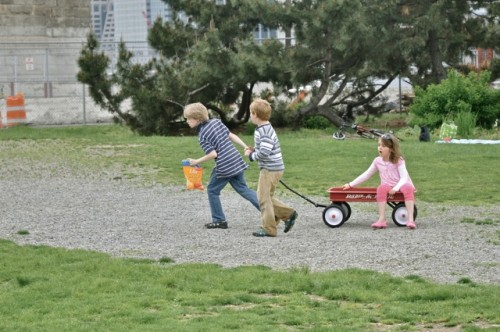 Kids don’t need a white picket fence to have fun.Photo: Sarah Goodyear
Kids don’t need a white picket fence to have fun.Photo: Sarah Goodyear
We cannot separate our children from the ills that affect everyone, however hard we try. — Erica Jong, “The Madness of Modern Motherhood,” in the Wall Street Journal
Most environmentally aware parents would say that we’d like to keep the planet in good shape for our kids. We’d like them to have clean air to breathe, healthy sources of food and water, and the good fortune to coexist with a variety of species of plants and animals. We’d also probably prefer that they not be drowned by rising sea levels before they reach retirement.
This is somewhat (OK, a lot) ironic, since many of the environmental ills that threaten our children’s futures have been exacerbated by our attempts to keep them safe in the here and now.
Allow me to explain.
We Americans tend to believe that a healthy environment in which to raise children is a large, single-family home in a quiet, suburban community. Many of us are convinced that trading the polluted, crowded city for greener pastures (also known as the large backyards that usually come along with suburban homes) is the right decision for our children. Unfortunately, the farther we move from urban centers, the more auto-dependent, resource-intensive, and by extension, environmentally detrimental our lives become. Auto-dependent living is bad for our children; it’s also very, very bad for the planet.
The energy efficiency of individual automobiles is a far less important environmental issue than the energy inefficiency of the asphalt-latticed way of life that we have built to oblige them- the sprawling American landscape of subdivisions, parking lots, strip malls and interstate bypasses. The critical energy drain in a typical American suburb is not the Hummer in the driveway; it’s everything the Hummer makes possible- the oversized houses and irrigated yards, the network of new feeder roads and residential streets, the costly and inefficient outward expansion of the power grid, the duplicated stores and schools, the two-hour solo commutes. — Green Metropolis: Why Living Smaller, Living Closer, and Driving Less Are the Keys to Sustainability, by David Owen
Certainly, every choice matters, and making an effort to do the little things right is important. (Lord knows I agonize over pretty much every child-related choice I’m presented with, to my husband’s great delight.) But folks, if you live in a sprawling, autocentric community that requires you to drive your kids to the supermarket to buy their organic produce and to the local playfield to get their exercise, you’re not doing them — or the planet — any favors.
Environmentally responsible parenting is about more than cloth diapers and BPA-free thermoses. It means drastically reducing the amount we consume and pollute. It means letting go of the belief that the best way to raise children is in a 2,500-square-foot, two-car home with a half-acre lawn, and instead embracing a different version of “family friendly”: dense, diverse, and transit-rich.
If you’re having a hard time accepting the idea that a whole bunch of people living in close proximity is good for the environment, read David Owen’s Green Metropolis (see above). It’s a thorough and clearly explained statement of the case. In the meantime, I’ll take a stab at an overview.
Living in a dense community means living in a smaller space. Smaller spaces require less energy to heat and cool. Smaller spaces take up less land, leaving room for more homes — and maybe even some forests and farmland. Smaller spaces also require us to limit the amount of “stuff” we accumulate, which in turn limits the amount of waste we produce.
As more people are living in close proximity to each other, more resources can be shared. Neighborhood parks replace large backyards; coffee shops and community centers replace home offices and playrooms; public libraries replace extensive personal libraries; and nearby theaters replace media rooms. Other resources, like power and sewer lines, can also be delivered more efficiently to densely populated communities.
Density supports alternative transportation. More people means more frequent and efficient transit service and more amenities within walking and cycling distance.
If you’re having a hard time accepting the idea that a whole bunch of people living in close proximity is good for families, consider that living in a dense, urban neighborhood can provide some of the same benefits for children as riding public transportation: exposure to a variety of people, sensory stimulation, and self-reliance, to name a few. Urban environments also provide innumerable cultural and social opportunities, those which suburban parents usually drive their children to cities to enjoy. Dense communities are arguably better for kids’ health than suburbs, because the built environment in urban environments is more likely to encourage walking and other forms of active transportation. And dense cities, despite their reputation for being cold, impersonal, and dangerous, actually foster community.
If you’re still not convinced, stay tuned. The focus of this column is to explore the relationship between families and cities — the many points of harmony and also the many points of tension — and to consider, in addition to policies that might make cities more family friendly, individual choices that can make families more, well — city friendly.



